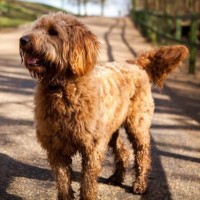 |
Chesa-Poo |
|
He is not recognized by the F.C.I. |
Origin |
U.S.A. <> France -> U.S.A. | |
Translation |
Francis Vandersteen |
A brief presentation of the Chesa-Poo |
| The Chesa-Poo is a large dog that is a specific cross between a Chesapeake Bay Retriever and a Poodle. They have thick, curly hair with a large, muscular frame, long legs and hairy, pendulous ears. Their tails are generally long and they have webbed paws. The Chesa-Poo makes an excellent pet because of its adorable personality and gentle manner. They love to hunt, so if you don't hunt, you'll have to chase rabbits and squirrels around the yard. Although they can be hard-headed, training isn't too difficult if you follow the rules and are consistent. The Chesa-Poo can come in almost any color and are generally solidly colored. |
History of the Chesa-Poo |
| The Chesa-Poo is considered a creative dog as opposed to a simple mixed breed, as it is the product of two purebred dogs. This type of breeding became popular in the 1980s with the intention of producing puppies that carried the desired characteristics of both parent breeds, usually a healthier, smaller, hypoallergenic or softer form of a popular breed. |
A little of the Chesapeake Bay Retriever |
||
| The Chesapeake Bay Retriever was founded in the 1800s in the United States as a hunting and retrieving dog. Their history indicates that they were the puppies of two Newfoundland dogs that were rescued by an American ship, the Canton, in 1807 from an English ship wrecked off the coast of Maryland. These two dogs were given to the rescuers as gifts and are said to be descendants of the Bloodhound, Irish Spaniel and other dogs. The female was a black dog named Canton and the male was a red dog named Sailor. However, others say they were crossed from the Curly-Coated Retriever, Flat-Coated Retriever and English Otterhound. They became famous for swimming the icy waters of the Chesapeake Bay to retrieve between 100 and 200 ducks a day. The Chesapeake Bay Retriever was recognized in 1878 by the American Kennel Club (AKC) and is now the 43rd most popular breed in the United States. It is also one of the few native breeds in the United States. | ||
 |
||
| Standard of the Chesapeake Bay Retriever | ||
A little of the Poodle |
||
| The Poodle originated in France in the 1500s as an artist, hunting dog and Retriever. However, some say they came from Denmark or Germany. Their first ancestors were curly-haired dogs from Asia and were water dogs. Their name comes from the German word, pfudel, meaning splash or puddle. They were popular in duck hunting, but soon became popular for other uses such as circus shows, military service, watchdog and guide. Their coats were usually shorn to help them swim, although some say that the swollen hair on their knees and tail was to protect them while hunting. However, the most popular belief is that the puffed hairstyle is for decorative purposes. They were accepted into the AKC in 1887 and are the 7th most popular dog in the USA. | ||
 |
||
| Standard of the Poodle |
Appearance of the Chesa-Poo |
| The Chesa-Poo is a large dog with a curly double coat that is thick and can be almost any color, including white, gray, yellow, tan, brown, black, red, blue and orange. They have long, strong legs, fuzzy hanging ears, a long hairy tail and large webbed paws that help them swim. Their face is more like a Poodle, while their body is more like a Chesapeake Bay Retriever. Their round eyes are dark and their nose is black. Most owners keep their Chesa-Poo groomed with a shorter coat in summer to keep them cooler and easier to care for. |
Temperament of the Chesa-Poo |
| Your Chesa-Poo may have a stubborn streak that makes it difficult to train. However, if you're consistent and use positive reinforcement, you shouldn't have too much trouble. These dogs like to be with their families and enjoy playing with children and other pets, although their hunting experience encourages them to chase neighborhood rabbits and squirrels when outdoors. The Chesa-Poo isn't so great a watchdog as it seems to love just about everyone, including strangers, but will bark like crazy if it has a reason to do so. It's important to keep them busy when you're away from home for a while, as they get lonely. |
Needs and activities of the Chesa-Poo |
| The Chesa-Poo needs plenty of activity every day to stay happy and healthy, such as long walks, hiking, a long game of fetch or a trip to the beach or dog park. They love to hunt and swim because of their parentage, which can be excellent activities for getting rid of excess energy. If your Chesa-Poo doesn't get enough exercise, it can become restless and bored, which is one of the main causes of behavior problems. In fact, you may come home to find your furniture and other household items used as chew toys. To avoid this problem, just make sure you provide your dog with at least one hour of exercise a day. |
Maintenance of the Chesa-Poo |
| Most Chesa-Poos owners will have their dogs professionally groomed every six months or so to keep their coats manageable. Even if you do this, you'll still need to brush and comb them carefully at least three or four times a week to prevent tangling. You should also make sure to keep their nails trimmed and teeth brushed to avoid dental disease. What's more, their hanging ears can be excellent breeding grounds for bacteria and mites, so you should check them once a week for redness, inflammation and any signs of trouble. |






 English (United Kingdom)
English (United Kingdom)